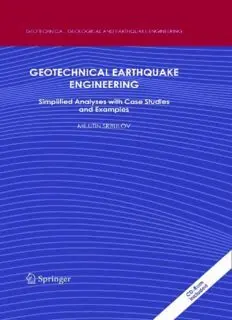Table Of ContentGEOTECHNICALEARTHQUAKEENGINEERING
GEOTECHNICAL, GEOLOGICAL AND EARTHQUAKE
ENGINEERING
Volume9
SeriesEditor
AtillaAnsal,KandilliObservatoryandEarthquakeResearchInstitute,
Bog˘azic¸iUniversity,Istanbul,Turkey
EditorialAdvisoryBoard
JulianBommer,ImperialCollegeLondon,U.K.
JonathanD.Bray,UniversityofCalifornia,Berkeley,U.S.A.
KyriazisPitilakis,AristotleUniversityofThessaloniki,Greece
SusumuYasuda,TokyoDenkiUniversity,Japan
Forothertitlespublishedinthisseries,goto
www.springer.com/series/6011
Geotechnical Earthquake
Engineering
Simplified Analyses with Case Studies
and Examples
by
MILUTIN SRBULOV
UnitedKingdom
withForewordof
E.T.R.Dean
123
Dr.MilutinSrbulov
UnitedKingdom
srbuluv@aol.com
ISBN:978-1-4020-8683-0 e-ISBN:978-1-4020-8684-7
LibraryofCongressControlNumber:2008931592
(cid:2)c 2008SpringerScience+BusinessMediaB.V.
Nopartofthisworkmaybereproduced,storedinaretrievalsystem,ortransmitted
inanyformorbyanymeans,electronic,mechanical,photocopying,microfilming,recording
orotherwise,withoutwrittenpermissionfromthePublisher,withtheexception
ofanymaterialsuppliedspecificallyforthepurposeofbeingentered
andexecutedonacomputersystem,forexclusiveusebythepurchaserofthework.
Printedonacid-freepaper
9 8 7 6 5 4 3 2 1
springer.com
Foreword
Measurable earthquakes occur very frequently in many parts of the world. For
example,Shepherd(1992)lists7283earthquakesrecordedintheCaribbeanAntilles
inthe22-yearperiod1964to1985,arateofabout1earthquakeperday.Somewere
due to movements of highly stressed rock at more than 100 km below the ground
surface(ShepherdandAspinall,1983).Similarhighlevelsofactivityarefoundin
allseismicallyactiveregionsoftheworld.
Astheearthquakevibrationstravelfromthesourcetowardsthegroundsurface,
theenergyspreadsoutandalsodissipates,sothatenergydensityreduceswithdis-
tance from source. For the majority of events, shaking has reduced to levels that
peoplecannotfeelbythetimeitreachesthegroundsurface.Forsomeevents,suf-
ficient energy reaches the surface for people to feel minor effects. For a few, the
energyreachingthesurfaceissufficienttocausemajordamage.
Since earthquake shaking is transmitted through ground, and since ground also
supportsbuildingsandotherstructures,theartandscienceofgeotechnicalengineer-
ingisanimportantpartofearthquakeengineering.Avarietyofconceptsandtech-
niques are detailed by Kramer (1996), Day (2002), Chen and Scawthorne (2003),
andothers.Someoftheimportantgeotechnicalaspectsare:
(cid:2)
The particle mechanical nature of soil (Mitchell and Soga, 2005; Lambe and
(cid:2) Whitman,1979)
(cid:2) Terzaghi’sPrincipleofEffectiveStress(Terzaghietal,1996)
(cid:2) Linear,isotropicelasticmodels(DavisandSelvadurai,1996)
Thetheoryofsoilplasticity(Drucker etal.,1957; Davisand Selvadurai, 2002;
(cid:2) Loret,1990)
(cid:2) TheMohr-Coulombfailureenvelope(LambeandWhitman,1979;Das,2004)
The characterization of soil properties, and theories of compressibility, flow of
water through soils, fluidization, and consolidation of soils (Florin and Ivanov,
1961;LambeandWhitman,1979;HeidariandJames,1982;WrothandHoulsby,
(cid:2) 1985;Terzaghietal,1996;Das,2004)
Criticalstatesoilmechanics,whichseekstoincorporatesoilelasticity,plasticity,
strength,density,andconsolidationintoasingleunifyingtheoreticalframework
(Schofield and Wroth, 1968; Atkinson and Bransby, 1978; Muir-Wood, 1992;
Schofield,2005)
v
vi Foreword
(cid:2)
Advancedsiteinvestigationandlaboratorytestingtechniques(Hunt,2005;Head,
(cid:2) 2006)
Advancedmethodsforslopestabilityassessment(Abramsonetal,1996;Corn-
forth,2005),andbearingcapacityandlateralearthpressure(eg.Choudharyetal,
(cid:2) 2004;KumarandGhosh,2006)
Liquefactionandthesteadystateconcept(Castro,1969;SeedandIdriss,1971;
Poulos, 1981; Vaid and Chern, 1985; Seed, 1988; Ishihara, 1995; Jefferies and
(cid:2) Been,2006)
Shaking table and centrifuge model testing (Schofield, 1980; Arulanandan and
(cid:2) Scott,1994;Taylor,1994)
Thedevelopingtheoriesofunsaturatedsoilmechanics(FredlundandRahardjo,
(cid:2) 1993)
Theuseofadvanceconstitutivemodels(Loret,1990;YamamuroandKaliakin,
2005)withfiniteelementmethods(ZienkiewiczandTaylor,1989,1991;Britto
(cid:2) andGunn,1987;Finn,1999;Potts,2003)
The global gathering, processing, and use of collective experience (Youd and
Idriss,2001)
Based on these and other factors, advances in understanding have been incor-
porated in design codes including the Uniform Building Code (UBC, 1997), the
International Building Code (IBC, 2006), Eurocode 8 (2004), API RP2A (2005),
ISO19901(2004),andmanyothers.
To support these developments, it can be highly desirable to document some
simplifiedmodelsthatareeasiertounderstand,retainandexplainthefundamental
physics involved, and provide ways of assessing the relevance, reliability, and ap-
plicability of more sophisticated approaches. It is also rather useful to be able to
identify the most significant publications in a technical literature that is now very
extensiveindeed.ThemonographpresentssomeoftheAuthor’sdescriptions,case
histories,experiencesandcommentsonavarietyofsimplifiedmodelsforengineer-
ing design and analysis. This is valuable both for persons new to the subject who
will learn of the wide-ranging considerations involved, and to other experienced
practitionerswhowillbeabletocompareexperienceswiththosesharedhere.
SeniorLecturerinGeotechnicalEngineering, E.T.R.Dean
UniversityoftheWestIndies
Preface
This monograph contains descriptions of numerous methods aimed at ease and
speedofuseformajorproblemsingeotechnicalearthquakeengineering.Comments
onassumptions,limitations,andfactorsaffectingtheresultsaregiven.Casestudies
and examples are included to illustrate the accuracy and usefulness of simplified
methods.Alistofreferencesisprovidedforfurtherconsiderations,ifdesired.Mi-
crosoftExcelworkbooksreferredtoinAppendicesandprovidedonanaccompany-
ingCDareforthecasestudiesandexamples consideredinthemonograph. Some
ofthereasonsforusingthismonographarementionedbelow.
Manycodesandstandardscontainrecommendationsonbestpracticebutcompli-
ancewiththemdoesnotnecessarilyconferimmunityfromrelevantstatutoryandle-
galrequirements(asstatedinBritishStandards).Someseismiccodesandstandards
wererevisedaftermajoreventssuchasthe1995Hyogo-kenNambuandthe1994
Northridge earthquakes. Codes contain clauses without references to the original
sourcesformoredetailedconsiderationswhencasesthatrequiresuchconsideration
appear in practice. Codes do not contain explanations of the statements expressed
in them. Codes are brief regarding ground properties and ground response. For
example, Eurocode 8 – Part 5 requires assessment of the effects of soil-structure
interactionincertaincircumstancesbutdoesnotspecifythedetailsoftheanalyses.
Therefore,theuseofcodesandstandardsalonemaynotbesufficientinengineering
practice.
Inengineeringpractice,thereisoftenratherlittleinteractionbetweenstructural
and foundation disciplines. Structural engineers often consider ground in a sim-
plified way using equivalent springs. Geotechnical engineers consider often only
loading from structures on foundations. Dynamic soil-structure interaction is very
complexandanalyzedmainlybyspecialistingeotechnicalearthquakeengineering.
Thismonographshouldhelpgeotechnicalandstructuralengineerstocommunicate
effectively to better understand solutions of many problems in geotechnical earth-
quakeengineering.
Specialists in non-linear dynamics analyses need to recognize that the motion
of a non-linear system can be chaotic and the outcomes can be unrepeatable and
unpredictable. Baker and Gollub (1992), for example, show that two conditions
are sufficient to give rise to the possibility of chaotic motion: the system has
at least three independent variables, and the variables are coupled by non-linear
vii
viii Preface
relations. Equivalent linear and simplified non-linear dynamic analysis described
in this monograph can be used to avoid possible chaotic outcomes of a complex
non-lineardynamicanalysis.Groundmotioncausedbyearthquakesischaoticand
therefore greater accuracy of sophisticated methods loses its advantage. Expected
ground motion can be predicted only approximately, and simplified analyses are
fasterandeasiertoolsforparametricstudiescomparedtosophisticatedmethods.
UnitedKingdom MilutinSrbulov
Acknowledgements
ProfessorMaksimovicpersuadedmetoswitchprofessionfromconcretestructures
to geotechnics right after my graduation. He pioneered studies of soil mechanics
paidbyEnergoprojektCo.atImperialCollegeintheU.K.TheMScsoilmechanics
studyin1984/85enabledmetoobtainthepositionofaresearchassistantlater.
I was honored and privileged to work with Professor Ambraseys on a number
of research projects supported by the Engineering and Physical Science Research
CounciloftheUnitedKingdomandbytheEPOCHprogramoftheCommunityof
European Countries at Imperial College in London during the period 1991–1997.
Thesimplifiedapproachusedinourresearchisdirectlyapplicabletoroutineengi-
neeringpractice.
Dr E.T.R. Dean reviewed several of my papers and was of great help with his
detailed and precise comments for the improvement of the initial versions of the
papers. He kindly reviewed the monograph and made a significant contribution
towardstheimprovementoftheclarityandreadabilityofthetext.
Elsevier publishers kindly granted permission to reproduce Fig. 5B, Fig. 10,
Fig. 11, 2/3 of Discussion, and Appendix A of the paper by Ambraseys and Sr-
bulov (1995) in print and electronic format in all languages and editions. Elsevier
publisherskindlygrantedpermissiontoreproducepages255to268ofthepaperby
Srbulov(2001)inprintandEnglishversion.
Patron Editore publishers kindly granted permission to reproduce parts of my
paperspublishedinthejournalEuropeanEarthquakeEngineering.
TheAmericanSocietyofCivilEngineerskindlygrantedpermissiontoreproduce
inprintandelectronicversionTable2fromZhangetal.(2005)paper.
ix

